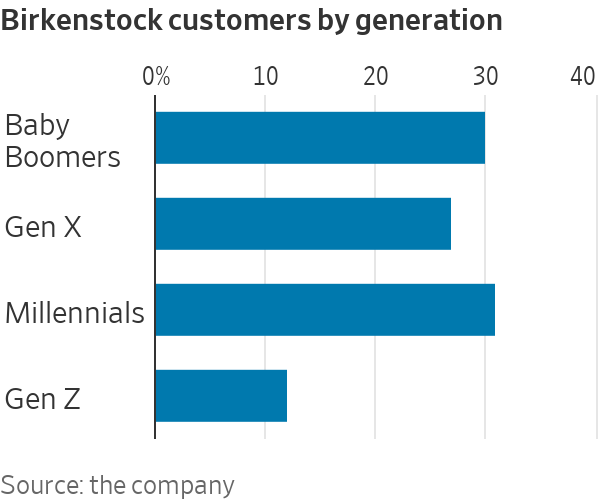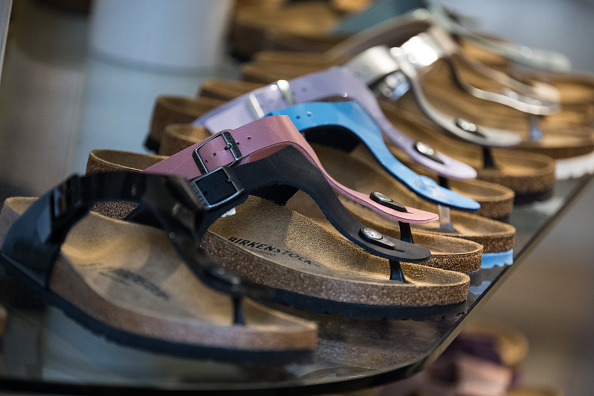Why Americans Are Obsessed With These Ugly Sandals
Margot Fraser’s feet hurt. Then she found Birkenstocks and brought them to the U.S. Now the company is worth billions of dollars.
One of the iconic shots of the year’s biggest movie was Margot Robbie’s Barbie character in Birkenstocks.
She was only wearing them because of Margot Fraser.
This woman responsible for bringing the supremely comfy, seductively ugly German footwear to the U.S. was one of the most improbable business figures of her time.
She was an accidental entrepreneur who started distributing Birkenstocks from her California home in the 1960s, when nobody knew what they were or how orthopaedic sandals cured foot pain. The only places that would carry them were health-food stores, where each pair might as well have come with a jar of granola. She was a dressmaker with no clue about shoes, much less crunchy ones, but she grew the company from zero to hundreds of millions of dollars in sales. She would even come to be known as Mrs. Birkenstock.
The sandals that she introduced to Americans have become more popular and the business much bigger than Fraser could have predicted. This week, when Birkenstock went public, the company was valued at $8.6 billion.
It’s fitting that Birkenstock’s initial public offering comes on the heels of a summer ruled by the spending power of women because this is a company whose U.S. business has always been built around their needs.
That’s in large part because of Margot Fraser, the most important woman in the company’s history. She paid attention to women—and it paid off. They were her first customers. They were also her best customers. Birkenstock’s financial documents credit “the breakthrough of modern feminism” as a key driver of its business, and the company’s private-equity backers cite the products’ appeal to women as one of the reasons they invested. In fact, Birkenstock says 72% of its customers are female.
It’s a remarkably high number for a company that explicitly markets its products as unisex. Steve Jobs wore them. Sneaker geeks want them. They were designed by Karl Birkenstock, a son of Carl and grandson of Konrad, descendants of the man who started the family’s tradition of shoemaking 249 years ago. More recently, the private-equity firm and family office of Bernard Arnault, the billionaire chief executive of LVMH’s luxury empire, bought a controlling stake and took the company public.
Anyone can now own stock in BIRK because of its connection to one of the world’s richest men, but Birkenstock never would have been in this position without a pioneering woman.
“It is because of Margot and the foundation she built that the brand is enjoying the success that it is today,” the president of the company’s American division said when she died in 2017.
She was the first to admit that she was an unlikely footwear executive and had to learn how to run the business one step at a time.
“I didn’t know a thing about shoes,” she once said. “What I did know was that my feet were always hurting.”
But that was all she needed to know. She figured that millions of women across the country must have feet that were always hurting, too.
Fraser had a keen sense of the American consumer for someone who grew up in war-torn Germany. The principal of her elementary school in the 1930s taught her that “girls were capable of anything and should follow their dreams,” but not everyone in her life agreed. “My mother thought that was all ridiculous feminist stuff,” Fraser wrote in a book offering business advice. Her father wasn’t exactly Betty Friedan, either. When she told him she wanted to travel the world for business and show people that “not all Germans were bad,” he responded: “My dear, you could never do that as a woman.”
She went to dressmaking school and moved to the countryside to make clothing for farmers, who paid her in eggs and butter. It was the teenager’s first taste of entrepreneurship. When she couldn’t see a future in Germany after World War II, she decided to leave home in pursuit of her childhood dream, and she boarded a trans-Atlantic ship with $25 in her pocket.
But it was only when Fraser returned as a tourist nearly 15 years later that she discovered the shoes that would rescue her feet and transform her life.

She was living in the U.S. when she took a spa trip back to Germany in 1966 and came across “sandals that weren’t pretty to look at.” But after years of trying anything to fix her aching feet—even standing on a phone book and gripping it with her toes—she tried on her first Birkenstocks.
She was pain-free within months.
Fraser realised that her feet were always hurting because of her painful footwear. No amount of standing on phone books would have made a difference for women in constrictive heels with pointed toes. What did make the difference for Fraser were these sandals made with leather, cork and a footbed the Birkenstock men invented. They were following in the footsteps of Johannes Birkenstock, which date back to 1774, when the cobbler was mentioned in the church records of a village near Frankfurt. The company’s first sandals were released in 1963, not long before Fraser slipped them on.
They were so comfortable that she didn’t care if they were ugly. Birkenstocks provided value because they solved a problem. They were basically Hokas for hippies.
Fraser took the sandals back to the U.S. and wrote to the Birkenstock family asking if she could sell them to Americans. They said yes to the dressmaker. At first, it seemed unwise. The owners of local shoe stores wouldn’t talk to her, and doctors treated her like a threat to the podiatry business.
She was desperate when a friend mentioned that a group called the Health Food Association was hosting a national convention nearby, which is how she found herself in a San Francisco hotel pitching sandals to people who sold lentils.
She needed to find people who didn’t mind how their shoes looked. As it turns out, they were the kind of people who owned health-food stores. Because they spent all day on their feet, they chose function over fashion. Fraser knew there would be a market for Birkenstocks when she spotted a woman at the convention shuffling around in nylons while carrying shoes that she couldn’t wear.
“The woman tried on a pair,” she wrote, “and bought them despite her husband’s protests.”
Once she had a foothold, Fraser began working out of her Bay Area home in 1967, calling her distribution company Birkenstock Footprint Sandals. She later renamed it Birkenstock USA.
She couldn’t have picked a better time or place for Birkenstocks to come plodding into the U.S. They would have crossed the ocean eventually, but the sandals became a symbol of rebellion because they landed in the heart of the counterculture, when and where people were allergic to the mainstream and willing to wear their antiestablishment values on their feet. “It was this perfect moment,” said Andrea Schneider-Braunberger, the curator of Birkenstock’s historical archives. “The culture was ready for such modern, convention-breaking shoes.”
Fraser worked closely with the Birkenstock family and shared their complete obsession with Birkenstocks. They made the shoes and decisions for the entire company based on her feedback.

The name of the funny-looking sandal that caught her eye was the “Original Birkenstock-Footbed sandal,” but Fraser told her German partners that American women were never going to buy something called “Original Birkenstock-Footbed sandal.” They took her marketing advice and branded the single-strapped sandal the “Madrid.” It remains one of the company’s top sellers.
It took six years for Fraser to venture beyond health-food stores and move into actual footwear stores. But that timing also turned out to be advantageous. By then, people were ready to buy Birkenstocks, and she was better at selling them.
She knew they intrigued baby boomers who didn’t want to look like their mothers and fathers. As it happens, their children don’t mind looking like them. Now, boomers and millennials make up almost the exact same percentage of Birkenstock’s consumers, and the company’s Arizona sandals and Boston clogs can be found in high schools and retirement homes.
The business is also barely recognisable from when she sold Birkenstock USA to her employees and retired in 2002. It was later folded into the German parent company, which is run by Oliver Reichert, the first person outside the Birkenstock family to be the CEO. Arnault’s L Catterton invested in 2021 with eyes on this week’s IPO.
Birkenstock has expanded into sneakers, boots and sandals in wool, shearling and waterproof material. Its proudly frumpy sandals meant to free women from the norms of fashion have become posh enough for celebrities, models and collaborations with Manolo Blahnik. The people who once turned up their noses at them now put their feet in them. And the company’s dominant market is the U.S.
None of that would have been possible without Margot Fraser.
Neither would the final scene in “Barbie.”
To sell more sandals to more Americans, she was always begging her partners for more colours, so Fraser would have been delighted to see what’s on the feet of another woman named Margot.
She’s wearing a pair of pink Birkenstocks.
 Copyright 2020, Dow Jones & Company, Inc. All Rights Reserved Worldwide. LEARN MORE
Copyright 2020, Dow Jones & Company, Inc. All Rights Reserved Worldwide. LEARN MORE
A divide has opened in the tech job market between those with artificial-intelligence skills and everyone else.
A 30-metre masterpiece unveiled in Monaco brings Lamborghini’s supercar drama to the high seas, powered by 7,600 horsepower and unmistakable Italian design.
A divide has opened in the tech job market between those with artificial-intelligence skills and everyone else.
There has rarely, if ever, been so much tech talent available in the job market. Yet many tech companies say good help is hard to find.
What gives?
U.S. colleges more than doubled the number of computer-science degrees awarded from 2013 to 2022, according to federal data. Then came round after round of layoffs at Google, Meta, Amazon, and others.
The Bureau of Labor Statistics predicts businesses will employ 6% fewer computer programmers in 2034 than they did last year.
All of this should, in theory, mean there is an ample supply of eager, capable engineers ready for hire.
But in their feverish pursuit of artificial-intelligence supremacy, employers say there aren’t enough people with the most in-demand skills. The few perceived as AI savants can command multimillion-dollar pay packages. On a second tier of AI savvy, workers can rake in close to $1 million a year .
Landing a job is tough for most everyone else.
Frustrated job seekers contend businesses could expand the AI talent pipeline with a little imagination. The argument is companies should accept that relatively few people have AI-specific experience because the technology is so new. They ought to focus on identifying candidates with transferable skills and let those people learn on the job.
Often, though, companies seem to hold out for dream candidates with deep backgrounds in machine learning. Many AI-related roles go unfilled for weeks or months—or get taken off job boards only to be reposted soon after.
Playing a different game
It is difficult to define what makes an AI all-star, but I’m sorry to report that it’s probably not whatever you’re doing.
Maybe you’re learning how to work more efficiently with the aid of ChatGPT and its robotic brethren. Perhaps you’re taking one of those innumerable AI certificate courses.
You might as well be playing pickup basketball at your local YMCA in hopes of being signed by the Los Angeles Lakers. The AI minds that companies truly covet are almost as rare as professional athletes.
“We’re talking about hundreds of people in the world, at the most,” says Cristóbal Valenzuela, chief executive of Runway, which makes AI image and video tools.
He describes it like this: Picture an AI model as a machine with 1,000 dials. The goal is to train the machine to detect patterns and predict outcomes. To do this, you have to feed it reams of data and know which dials to adjust—and by how much.
The universe of people with the right touch is confined to those with uncanny intuition, genius-level smarts or the foresight (possibly luck) to go into AI many years ago, before it was all the rage.
As a venture-backed startup with about 120 employees, Runway doesn’t necessarily vie with Silicon Valley giants for the AI job market’s version of LeBron James. But when I spoke with Valenzuela recently, his company was advertising base salaries of up to $440,000 for an engineering manager and $490,000 for a director of machine learning.
A job listing like one of these might attract 2,000 applicants in a week, Valenzuela says, and there is a decent chance he won’t pick any of them. A lot of people who claim to be AI literate merely produce “workslop”—generic, low-quality material. He spends a lot of time reading academic journals and browsing GitHub portfolios, and recruiting people whose work impresses him.
In addition to an uncommon skill set, companies trying to win in the hypercompetitive AI arena are scouting for commitment bordering on fanaticism .
Daniel Park is seeking three new members for his nine-person startup. He says he will wait a year or longer if that’s what it takes to fill roles with advertised base salaries of up to $500,000.
He’s looking for “prodigies” willing to work seven days a week. Much of the team lives together in a six-bedroom house in San Francisco.
If this sounds like a lonely existence, Park’s team members may be able to solve their own problem. His company, Pickle, aims to develop personalised AI companions akin to Tony Stark’s Jarvis in “Iron Man.”
Overlooked
James Strawn wasn’t an AI early adopter, and the father of two teenagers doesn’t want to sacrifice his personal life for a job. He is beginning to wonder whether there is still a place for people like him in the tech sector.
He was laid off over the summer after 25 years at Adobe , where he was a senior software quality-assurance engineer. Strawn, 55, started as a contractor and recalls his hiring as a leap of faith by the company.
He had been an artist and graphic designer. The managers who interviewed him figured he could use that background to help make Illustrator and other Adobe software more user-friendly.
Looking for work now, he doesn’t see the same willingness by companies to take a chance on someone whose résumé isn’t a perfect match to the job description. He’s had one interview since his layoff.
“I always thought my years of experience at a high-profile company would at least be enough to get me interviews where I could explain how I could contribute,” says Strawn, who is taking foundational AI courses. “It’s just not like that.”
The trouble for people starting out in AI—whether recent grads or job switchers like Strawn—is that companies see them as a dime a dozen.
“There’s this AI arms race, and the fact of the matter is entry-level people aren’t going to help you win it,” says Matt Massucci, CEO of the tech recruiting firm Hirewell. “There’s this concept of the 10x engineer—the one engineer who can do the work of 10. That’s what companies are really leaning into and paying for.”
He adds that companies can automate some low-level engineering tasks, which frees up more money to throw at high-end talent.
It’s a dynamic that creates a few handsomely paid haves and a lot more have-nots.
Australia’s market is on the move again, and not always where you’d expect. We’ve found the surprise suburbs where prices are climbing fastest.
Ophora Tallawong has launched its final release of quality apartments priced under $700,000.






















